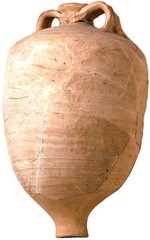Roman Amphorae: a digital resource
University of Southampton, 2005. (updated 2014) https://doi.org/10.5284/1028192. How to cite using this DOI
Data copyright © University of Southampton unless otherwise stated
This work is licensed under the ADS Terms of Use and Access.
Primary contact
Dr
David
Williams
Dept of Archaeology
University of Southampton
Avenue Campus
Highfield
Southampton
SO17 1BJ
England
Tel: 080 593032
Resource identifiers
- ADS Collection: 463
- DOI:https://doi.org/10.5284/1028192
- How to cite using this DOI
Gauloise 4

Courtesy of Verulamium Museum
Kate Warren
Variants of Gauloise 4:[Gauloise 4 similis - Almadrava 3] | ||
Distinctive FeaturesThis amphora has a narrow flat ringed base. The maximum diameter of the body (towards the top), is around five times greater that that of the foot. It takes the form of bead rim and the handles have a groove with traces of smoothing to attach them (Laubenheimer, 1985). The form was also copied elsewhere (Laubenheimer & Gisbert Santonia, 2001; Symonds, 2003).See characteristics | ||
Date RangeFrom around AD 50 to the end of the third century AD.Search: [1st century AD] [2nd century AD] [3rd century AD] | ||
OriginThe majority of the production is localised in the Narbonne region where thirty-six workshops were located, as well as in Languedoc and in Provence (Laubenheimer, 1985; Laubenheimer & Schmitt, forthcoming). Their products are characterised by a calcareous fabric.Imitations are often found in other parts of France with different fabrics and in reduced quantities (Laubenheimer, 2003; Olmer, 1996; Misone et alii, 1998: 155-6), as well as in Spain (Laubenheimer & Gisbert Santonia, 2001; Symonds, 2003). Search: [France] [North West Europe] | ||
DistributionThe Narbonnensian production was essentially destined for export. The amphorae are largely distributed along the waterways of the Rhône-Saône-Rhine and Seine, towards the Rhine limes and to Britain (Remesal Rodríguez and Revilla, 1991). In the south, they are largely distributed in the Mediterannean towards Rome and Ostia. Beyond Italy they are also found in Lusitania (Fabião, pers.comm.), at Athens, in Crete and Cyprus, along the coast of Turkey, at Alexandria in Egypt and along the route from the Nile to the Red Sea. The furthest extreme is in southern India at Arikamedu (Laubenheimer, 2001).The amphorae produced elsewhere in France are considerably less numerous and seems to have only had a very local distribution. Search: [Crete] [Cyprus] [Eastern Mediterranean] [Egypt] [France] [Germany] [Great Britain] [Greece] [India] [Italy] [North Africa] [North West Europe] [Portugal] [Spain] [Western Asia Minor] | ||
ContentsWine for the Narbonnensian version, according to numerous tituli picti which mention different types of wine, including amineum and picatum (Laubenheimer, 2004).Search: [Wine] | ||
CommentsPrincipal contributor: Fanette Laubenheimer | ||
ClassificationAugst 12Callender 10 Niederbieber 76 Ostia 60 Peacock & Williams 27 Pélichet 47 | ||
CEIPAC linkThe following link will take you to the Centro para el Estudio de la Interdependencia Provincial en la Antiguedad Clásica CEIPAC database. In the CEIPAC system this amphora has the ID KE51+BYZ. Note: access to CEIPAC requires registration, which is possible via http://ceipac.ub.edu/corpus_reg.php?IDM=e | ||
Terres dâAmphoresTerres dâAmphoresThe above link will take you to the new digital database of amphora types and fabrics from Gaulish production centres, 1st - 3rd century A.D. (Maison Archéologie & Ethnologie, René-Ginouvès). | ||



 3D models
3D models


